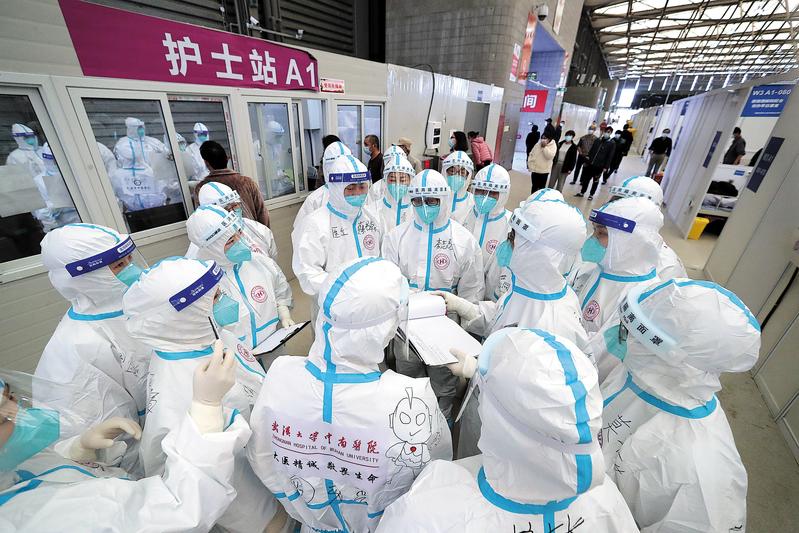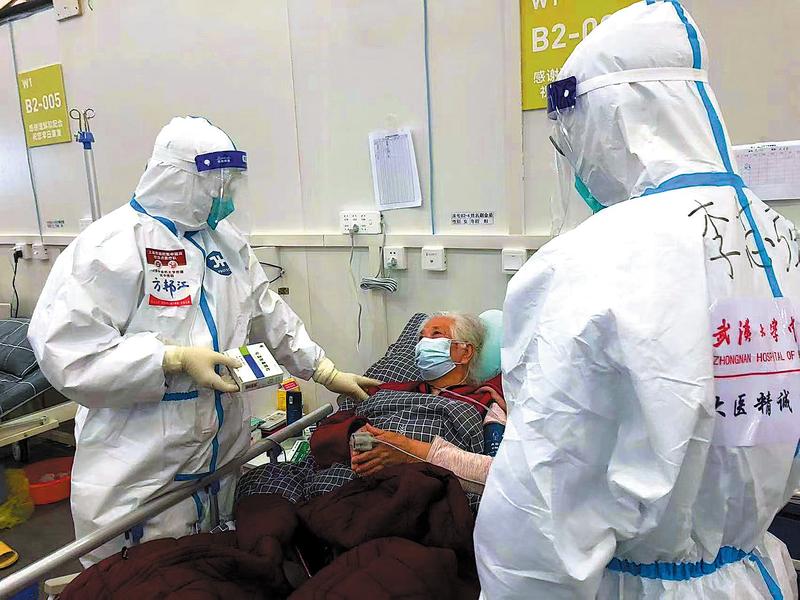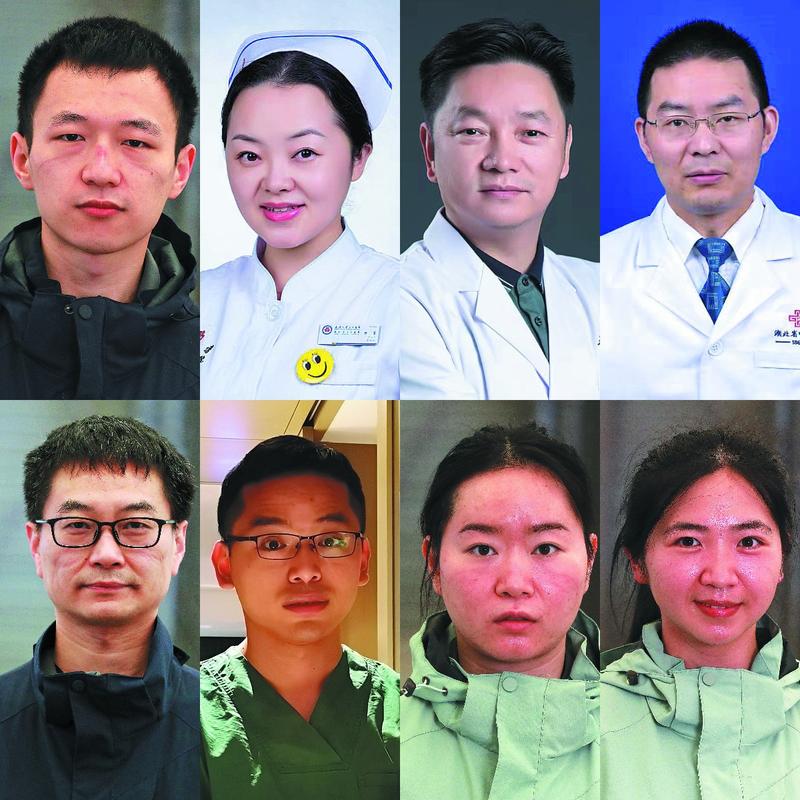Healthcare workers from city, Wuhan pool their experience on front line
 Medical workers from Hubei check information at a makeshift hospital in Pudong New Area, Shanghai. (ZHU XINGXIN / CHINA DAILY)
Medical workers from Hubei check information at a makeshift hospital in Pudong New Area, Shanghai. (ZHU XINGXIN / CHINA DAILY)
After signing up to help tackle Shanghai's latest wave of COVID-19, Chen Lei, 41, a nurse from Renmin Hospital of Wuhan University, Hubei province, did not immediately tell her family.
The first person to hear of Chen's decision was Wei Yin, a nurse in Shanghai.
In a text message sent to Wei on the afternoon on April 2, Chen wrote, "I'm going to fight the outbreak with you side by side."
Chen had no hesitation in making her decision, because Wei, who works at Shanghai Huashan Hospital, traveled to Wuhan to help the city when it was hit hard by COVID-19 in early 2020. "Our friendship has developed since then," Chen said.
Within minutes of contacting Wei, Chen received a reply from her friend, who tried to persuade her not to travel to Shanghai.
"It is easier to become infected with the current virus, which would be a more dangerous situation than two years ago. We also won't be able to see each other this time," said Wei, a Shanghai native.
Wei also phoned Chen to tell her about the high risk of infection, but Chen was determined to join the frontline battle against the outbreak. "It's what a medic should do, and also what a friend should do," she said.
At 6 pm on April 3, Chen arrived in Shanghai with some 50 medics from her hospital in Wuhan.
 A girl studies at the makeshift hospital in Pudong. (ZHU XINGXIN / CHINA DAILY)
A girl studies at the makeshift hospital in Pudong. (ZHU XINGXIN / CHINA DAILY)
After about two days of preparation and training, they began nursing people infected with the virus at a makeshift hospital at the Shanghai New International Expo Center in Pudong New Area.
Medical workers from Tianjin, and Hubei and Jiangxi provinces are in charge of the temporary hospital, which has a capacity of 15,000 beds. As of May 1, more than 30,000 patients who recovered from infection had been discharged from the facility.
Before starting work at the makeshift hospital, Chen and her colleagues from Wuhan learned how to say "fever" and "headache" in the Shanghai dialect, to better ease patients' fears and learn more about their needs.
Wei taught Chen the dialect, giving her personal mentoring via video link.
Chen and Wei, who are of a similar age, met during the battle against COVID-19 in Wuhan, and found that they had similar ideas about their work.
Over the past two years on WeChat, they have shared medical knowledge and interesting stories about life.
Chen said, "I've always appreciated the timely and strong support provided by the Shanghai medical team two years ago, so this time, when they encountered difficulty in Shanghai, I was duty-bound to help."
Zhao Kaochang, a respiratory physician from Wuhan who traveled to help Shanghai, also expressed his thanks for the efforts made by Shanghai medics in 2020.
"I feel it is my responsibility to repay the favor, and I want to fight with them shoulder to shoulder," he said.
 Patients show their gratitude to medical workers at the facility. (ZHU XINGXIN / CHINA DAILY)
Patients show their gratitude to medical workers at the facility. (ZHU XINGXIN / CHINA DAILY)
Expertise gained
The medics from Wuhan said they also traveled to Shanghai to help during the latest outbreak because the infections in their hometown two years ago provided them with the expertise to treat COVID-19 cases.
They have rich experience of conducting mass nucleic acid sampling, organizing quarantine, and managing makeshift hospitals.
Xiao Mingzhong, a practitioner from Hubei Provincial Hospital of Traditional Chinese Medicine in Wuhan, said that although Shanghai has been hit by the Omicron variant, which is different to the variant experienced in Wuhan, "some treatment experience, I believe, may still work this time."
Zhao also voiced his confidence in curbing the fast spread of the Omicron variant.
"Things were a little bit hectic at first, as the number of symptomatic cases across Shanghai grew rapidly in early and mid-April. It was difficult for we 50 medical workers to look after more than 1,300 patients at a time," he said.
To solve the problem and keep the makeshift hospital running efficiently, Shen Bo, vice-president of Renmin Hospital of Wuhan University, quickly optimized the workflow, dividing the temporary facility into several zones and allocating some beds especially for the elderly and patients with underlying diseases.
Shen said, "The fatality rate from the Omicron variant is not as high as that from the variant in Wuhan, but if we don't provide sufficient medical observation for elderly patients with underlying conditions, they may face emergencies or even become severely ill."
To ensure the health safety of such patients and give them extra attention, medics must first learn about their underlying conditions and allocate a group to treat them in a special ward, Shen said.
"If these patients' symptoms become serious, we can directly transfer them to a designated hospital as quickly as possible. In this way, we can provide hospitals with sufficient information about the patients' underlying diseases and provide treatment for them in the special ward," he added.
"The clearer the functions of zones at the makeshift hospital are, the more organized the workflow will be," he said, adding that the experience gained in managing treatment of the Omicron variant should be used more widely.
 Doctors examine a patient at the makeshift hospital. (PHOTO PROVIDED TO CHINA DAILY)
Doctors examine a patient at the makeshift hospital. (PHOTO PROVIDED TO CHINA DAILY)
Similar problems
Zhao, the respiratory physician, said he could better understand just how urgent the situation in Shanghai was, and the kind of help the city most needed, because Wuhan, where he lives and works, faced similar problems two years ago.
After working in the makeshift hospital in Pudong New Area for about 50 days, Zhao said, "This period not only witnessed friendship among medics, but also the mutual support of the two cities."
During the fight against the outbreak, Chen Qin, a nurse from Zhongnan Hospital of Wuhan University in Hubei, spent her spare time painting the Oriental Pearl Tower in Shanghai and Huanghelou Tower, a landmark building in Wuhan, on a wall at the makeshift hospital.
Between these two artistic depictions, Chen Qin daubed a rainbow, symbolizing the close connections of residents and medics in the two cities and their determination and joint efforts to fight the outbreak.
Murals and paintings in the makeshift hospital have become popular among medical workers and patients, inspiring a sense of hope during a difficult time.
Unlike Chen Qin, who traveled to Shanghai for the first time, her colleague Tong Li first visited the city during World Expo 2010.
Tong said: "I was impressed with the beauty of Shanghai. This time, I've built more emotional connections, and I believe the epidemic will soon disappear, as long as we work hard together."
On April 3, Xiao, from the TCM hospital in Wuhan, led a team of 26 medics to Shanghai. All the team members took part in the battle against the epidemic in Wuhan.
Xiao said that when the lockdown was introduced in Shanghai, he thought back to the situation in Wuhan two years ago. "I can better sense the feelings of Shanghai people, and that's why I'm here to help them fight the epidemic," he added.
 From top left to bottom right: Xu Xirui, Chen Lei, Shen Bo, Xiao Mingzhong, Li Zhiqiang, Zhao Kaochang, Chen Qin and Tan Miao, members of the team from Hubei province that arrived in Shanghai at the start of last month to help the city fight COVID-19. They provided medical expertise and rich experience in conducting mass nucleic acid sampling, organizing quarantine, and managing makeshift hospitals. (PHOTO PROVIDED TO CHINA DAILY)
From top left to bottom right: Xu Xirui, Chen Lei, Shen Bo, Xiao Mingzhong, Li Zhiqiang, Zhao Kaochang, Chen Qin and Tan Miao, members of the team from Hubei province that arrived in Shanghai at the start of last month to help the city fight COVID-19. They provided medical expertise and rich experience in conducting mass nucleic acid sampling, organizing quarantine, and managing makeshift hospitals. (PHOTO PROVIDED TO CHINA DAILY)
Young professionals
Many of the medics from Wuhan supporting Shanghai are young professionals who were encouraged by their peers from across China who battled the epidemic in 2020.
Li Zhiqiang, vice-president of Zhongnan Hospital of Wuhan University, said 71 medical workers were sent from the hospital to Shanghai to fight the current outbreak.
The first batch of 51 medics are responsible for patients at the makeshift hospital in Pudong, while the second batch of 20 treat severe cases at Shanghai Huashan Hospital.
The average age of the medical team members is 32, Li said.
Tan Miao, 30, the mother of a 2-year-old son, said that when she first arrived in Shanghai, she missed him very much, calling him at home every day.
But she quickly adapted to the situation. Instead of making video calls during breaks from work, she spent more time reading books, "as I realized the quick way to be reunited with my family was to focus more on work and first accomplish what I was sent here to do," she said.
Xu Xirui, 25, said he sometimes felt under great pressure due to the workload at the makeshift hospital, but he regards this as a good experience that enriched his life.
"I'm young, so joining the frontline is a good opportunity for me to accumulate some nursing experience. I'm also energetic. It's rewarding to comfort infected patients and alleviate their anxiety," he said.
Li praised the vitality of the young medical team members, adding that their attentive care has also played a role in keeping patients' spirits up.


